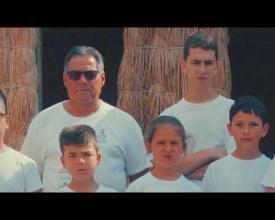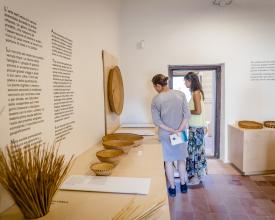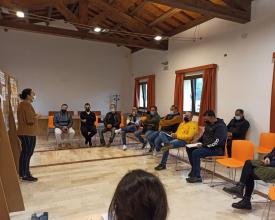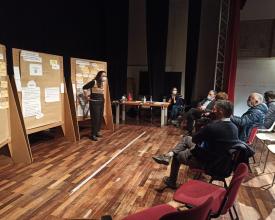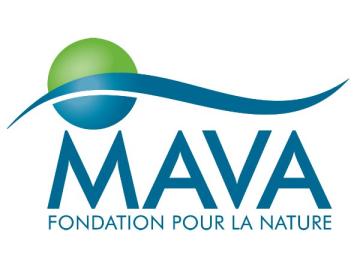
Maristanis: an integrated coastal and wetlands management

The proposed intervention is part of a complex project, Maristanis, funded by the Mava Foundation and coordinated by the MEDSEA Foundation. Maristanis developed activities regarding governance, water quality and saving, restoration (sea and land-based) and agriculture and fishing involvement. In the governance framework, the project focussed on creating an integrated management model offering a long-term management strategy for the coastal wetlands found in the Gulf of Oristano – a new regional park. It contributed to balancing social and environmental needs and paved the way to recognise the economic and cultural potential of the wetlands. As the implementation of the intervention was still underway, a self-assessment using the IUCN Global Standard for Nature-based Solutionsᵀᴹ was carried out. It was used to identify entry points to strengthen the intervention under the umbrella of Nature-based Solutions.
Context
Challenges addressed
Overexploitation, land-use changes, hydrological alterations, pollution and anthropogenic pressures pose risks to ecosystem health and biodiversity as well as the economic, social and cultural benefits derived from the wetland ecosystems. The coastal area of the Gulf of Oristano includes six Ramsar sites, 19 Natura 2000 sites in 11 municipalities and one Marine Protected Area across approx. 7,700 ha along 140 km of coastline.
The presence of 11 Municipalities determines some failures in wetlands management. The presence of a single authority devoted to wetlands management (a Regional Park) would guarantee a greater commitment also in the search for regular funds and consequently better planning of activities in the medium and long term. The main economic activities in the region include artisanal fishing, agriculture and tourism, which have often different needs and perceptions of the wetlands.
Location
Process
Summary of the process
The building blocks highlight a number of key insights that emerged from the assessment of the integrated coastal and wetlands management intervention in the Gulf of Oristano.
Strong analysis and data collection carried out over the five years of the project provided the basis for interlinking all the activities developed in the project and emphasised in the Building Blocks.
This activity facilitated and made efficient the work of the Coastal Contract Technical Secretariat, which accompanied the municipalities in the administrative and technical procedures of defining the strategic objectives and actions of the Coastal Wetland Contract.
Finally, a wide-ranging process of involvement and awareness-raising of key actors in the area, agricultural sector, fishing, tourism, environmental associations, etc. accompanied the project in all its phases and activities, in particular during the definition of the Coastal Wetland Contract. Both individual and public meetings were used.
Building Blocks
The Maristanis project, through restoration, species protection and efficient use of water
The Maristanis project is focused on different topics: governance, restoration, water consumption, protection of protected species and cultural heritage. A selection of implemented activities is reported below:
The Renaturalisation and restoration of a riparian strip in the Sal'e Porcus pond aims at thickening the vegetated areas along the pond banks, creating a filter zone between the areas dedicated to agricultural activity and those of higher natural value. This improves the health of the habitats present and reduces their fragmentation and the conservation status of the ecosystems.
An artificial island for nesting has been created with waste products from mussel farming, mussel shells that cannot be sold or that are leftover from production, with the aim of nesting important species of sea birds, Terns and Laryngites, that already frequent the area.
A precision agriculture project has been developed in the area focusing on the efficient use of water and other inputs (including chemical products such as fertilisers, herbicides and pesticides). Several technologies were tested in pilot projects to reduce water use in farming activities. The most successful pilot experience was the use of drones to map the soil and check for water and other input requirements.
Enabling factors
During the project implementation, the active involvement of stakeholders and raising awareness have been very relevant. More than 400 stakeholders were involved in the activities directly or indirectly, particularly from the agriculture, fisheries and tourism sectors.
An important awareness-raising action has been developed with the schools on WWD and Coast Day, with clean-up, training events, competitions and the creation of an educational kit.
Lesson learned
The experience has highlighted the importance of collaboration between local actors and how multi-objective interventions can be the winning key to increasing the support of the local population and administrations as a single intervention has benefits for different categories of stakeholders and promotes multiple ecosystem services.
The artificial island is an opportunity to combine the productive reality with the naturalistic one to amplify the conservation potential of the area and make it a unique reality in Sardinia. The outcome is conditioned by external conditions that are not directly linked to the intervention. Constant monitoring is necessary to increase or modify the nesting support action.
The precision agriculture project with the drone turned out to be an efficient technology. Results show that irrigation based on drone-collected data can lead to a 30% water saving and fertilisers reduction. Due to the low cost per hectare compared to other technologies (such as micro or sub-irrigation) is especially efficient for large size croplands and water-intensive crops, such as maize and rice.
A strong legal basis to ensure integrated governance
The intervention involves the 11 municipalities that cover the six Ramsar sites and 19 Natura 2000 sites. They signed a cooperation agreement for joint decision-making in the form of the Oristano Coastal Wetlands Contract, under the Italian legislation that regulates the river contracts (art. 68-bis Legislative Decree 152/2006), The Contract defines strategies, guidelines and actions that steer the definition of intended outcomes and actions and inform monitoring and evaluation of the intervention.
The Action Plan, attached to the Contract, summarises the planning of actions, funded and not, regarding the main important issues, such as restoration, climate change, water quality, hydrological risk, cultural and landscape promotion and valorisation. As part of the implementation of the Nature-based Solution, relevant public and private sector stakeholders were consulted. They were identified based on stakeholder analysis and include affected sectors.
Enabling factors
The Contract is an important legal instrument as it reinforces the commitment towards joint policy action to overcome the fragmentation of coastal wetlands management, looking towards the establishment of a new regional protected area, which is the first aim of the Action Plan attached to the Contract. It provides the foundation for Nature-based Solution actions in the Gulf of Oristano.
Lesson learned
The adoption of the Oristano Coastal Wetlands Contract (CWC) by the 11 municipalities provided an important legal basis and framework to advance the integrated management of six wetlands in the Gulf of Oristano. An integrated and unique system of governance was needed in a framework characterized by fragmented wetland management (between regional and local government) and similar problems and ecosystem shared in all wetlands. The CWC provided strategies and actions that support ongoing efforts toward the establishment of a new regional park. The Regional Park can manage and coordinate the public bodies involved. Moreover, the possibility to lighten the administrative and evaluation process, considering the main aspects, environmental and economic, such as biodiversity and ecosystem conservation, climate mitigation, fishing, agriculture, tourism, etc. The establishment of a formal, clear and well-documented feedback grievance mechanism, as well as participatory decision-making processes respecting the rights and interests of all participating and affected stakeholders, were added as priority actions going forward.
Defining priority and corrective actions to strengthen the intervention
During the implementation of the intervention, the project team conducted the self-assessment as part of the IUCN Global Standard for Nature-based Solutionsᵀᴹ. The assessment provided information about the intervention’s strengths and weaknesses and helped derive concrete recommendations and actions that could be implemented during the remainder of the project. The analysis was carried out by the UNEP Regional Activity Centre for Sustainable Consumption and Production (SCP/RAC) of the Mediterranean Action Plan (MAP) of the UN Environment Programme and recommendations published in a report.
Enabling factors
The assessment was supported by a consultant from the IUCN Commission on Ecosystem Management, who supported the team with the completion of the self-assessment and provided clarification on specific criteria and indicators.
Lesson learned
An analysis of the IUCN Global Standard for Nature-based Solutionsᵀᴹ indicators that have been insufficiently or only partially addressed helped to make recommendations for improvement and to identify concrete corrective actions to strengthen the implementation of the intervention. This demonstrates how the self-assessment can be used to strengthen the design and implementation of Nature-based Solutions.
Impacts
The main positive impact of the proposed and implemented governance model is to guarantee management and coordination between the several involved actors (11 municipalities, the regional government, the water authority, more than 50 main economic companies, etc.), The scope of the governance is to strengthen the conservation of coastal and marine habitats, reinforce resilience to climate change impacts and reduce water consumption, abstraction, pollution and contamination. More than 70 stakeholders participated in the 9 official meetings of the participation process presenting the Coastal Wetland Contract and the opportunities arising from the institution of a Regional Park.
Speaking instead of the more practical activities:
- The area that has benefited from the restoration measures developed in the project is estimated at about 600 ha.
- The new island for bird nesting has a surface of 110 square meters, a building with 143 cubic meters of mussels inside to 1100 jute sacks.
- Precision agriculture measures were tested on more than 200 hectares, mainly with drones on maize and rice cultivation. Sub-irrigation technologies were tested on 9 hectares cultivated with (organic) artichokes and strawberries, and surface micro-irrigation on three carrot hectares. A precision agriculture project with satellites on 5000 hectares, mainly used to cultivate maize for feeding cattle, was developed.
Beneficiaries
Fisheries and farming associations, territorial authorities, local companies, fishermen, farmers, tourism operators
Sustainable Development Goals
Story
“The Maristanis Contract can allow us to overcome a series of constraints related to the provisions on aid to businesses, especially those in the fishing sector, which more than any other is suffering because of climate change. The Coastal Contract may become a driving force for investments. The fishing sector needs it. There’s still a lot to be developed". Alessandro Porcu, technical director of the S. Andrew Fishermen's Cooperative.
"Our territory is characterized by its inability to transform resources into products. Travellers who visit the Gulf of Oristano complain about the absence of a system that makes environment, culture and tourism parts of the same system. We hope that the park will create these conditions in the shortest possible time". Maria Roberta Sanna, owner of the Mistral I and Mistral II hotels in Oristano.
"The creation of a park can also positively influence the approach to tourism, making it more aware of the extraordinary importance that the six Ramsar sites of Oristano represent in terms of wildlife". Gabriele Pinna, ornithologist and president of the LIPU of Oristano
"The creation of the park and an integrated governance is “desirable”. The Coastal Agreement is the place for discussion and synthesis that can simplify the bureaucratic processes, often a burden to the entrepreneurs' initiatives, especially when they want innovation to intercept the environmental need". Paolo Mele, president of Confagricoltura Sardegna.
"The contract provides us with a great tool, especially when it comes to bureaucratic simplification. Streamlining the dialogue between companies and institutions is of major importance. It is up to us, then, to take advantage of it and seize this great opportunity”. Andrea Liverani, Smart Geo Survey s.r.l. and local entrepreneur
"The Coastal Contract is with no doubt a useful tool to promote the area and contribute to local development. Being part of this group will allow us to propose paths and objectives that go in the direction of protecting nature and sustainable development”. Francesca Figus, marketing manager of Nieddittas, a leading mussels-farming company in the Gulf of Oristano.
